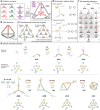Developmental self-assembly of a DNA tetrahedron
- PMID: 24720462
- PMCID: PMC4004324
- DOI: 10.1021/nn4038223
Developmental self-assembly of a DNA tetrahedron
Abstract
Kinetically controlled isothermal growth is fundamental to biological development, yet it remains challenging to rationally design molecular systems that self-assemble isothermally into complex geometries via prescribed assembly and disassembly pathways. By exploiting the programmable chemistry of base pairing, sophisticated spatial and temporal control have been demonstrated in DNA self-assembly, but largely as separate pursuits. By integrating temporal with spatial control, here we demonstrate the "developmental" self-assembly of a DNA tetrahedron, where a prescriptive molecular program orchestrates the kinetic pathways by which DNA molecules isothermally self-assemble into a well-defined three-dimensional wireframe geometry. In this reaction, nine DNA reactants initially coexist metastably, but upon catalysis by a DNA initiator molecule, navigate 24 individually characterizable intermediate states via prescribed assembly pathways, organized both in series and in parallel, to arrive at the tetrahedral final product. In contrast to previous work on dynamic DNA nanotechnology, this developmental program coordinates growth of ringed substructures into a three-dimensional wireframe superstructure, taking a step toward the goal of kinetically controlled isothermal growth of complex three-dimensional geometries.
Figures




References
-
- Seeman N. C. Nucleic Acid Junctions and Lattices. J. Theor. Biol. 1982, 99, 237–247. - PubMed
-
- Seeman N. C. DNA in a Material World. Nature 2003, 421, 427–431. - PubMed
-
- Yin P.; Hariadi R.; Sahu S.; Choi H. M. T.; Park S. H.; LaBean T. H.; Reif J. H. Programming Molecular Tube Circumferences. Science 2008, 321, 824–826. - PubMed
Publication types
MeSH terms
Substances
Grants and funding
LinkOut - more resources
Full Text Sources
Other Literature Sources

